|
|||||||||
|
HERITAGE AND ARCHAEOLOGICAL NEWS BRIEFSNEW LIAONING MUSEUM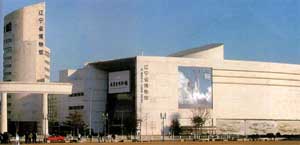 Fig. 1 External view of the new Liaoning Provincial Museum On 12 November 2004 the impressive new Liaoning Provincial Museum (Liaoning Sheng Bowuguan)(see Fig. 1) in Shenyang opened to the public. As the early Manchu capital, Shenyang has its own Forbidden City and Qing tombs complexes in what was once the Manchu heartland, where both the Later Jin and then the Qing dynasties were proclaimed. With the 20th century Japanese invasion of China, the Japanese appealed to north-east China's Manchu heritage, installing the last emperor of the Qing dynasty, Puyi, as head of the Manchukuo puppet monarchy. This historical background has ensured that Shenyang has come to acquire rich imperial Qing collections of calligraphy, painting and porcelain, and these are displayed in the new museum to full advantage. Many of the technical and security facilities of the new museum were tendered to a Singaporean company. Visitors to the new museum have a chance to see Zhang Zeduan's renowned Song dynasty masterpiece Qingming shanghe tu (Ascending the River on Qingming Festival), once in the collection of Emperor Puyi. YANGZHOU EMBARKS ON MUSEUM CONSTRUCTION DRIVEAt the beginning of March 2005 Yangzhou municipal authorities announced that the city was planning to built ten new museums over the next few years devoted to folklorica, potted landscapes, traditional Chinese medicine (TCM), urban industry, animal species, Yangzhou cuisine, canal culture, Buddhism, and bridges, as well as an art exhibition centre. FREE MUSEUM ENTRY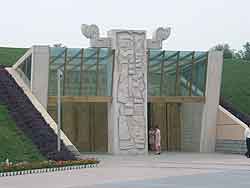 Fig. 2 View of the entrance of the Sanxingdui Museum, Guanghan city, Sichuan province [BGD] The Ministry of Culture and the State Administration of Cultural Heritage announced that from 1 May 2004 onwards, all museums, memorial halls, libraries and art galleries supervised by the Ministry of Culture and State Administration of Cultural Heritage will offer free entrance to those under 18 years if accompanied by a teacher or parent. Zhejiang Province went further, and after the Zhejiang Museum and Hangzhou China Silk Museum introduced a policy of free entrance for all in 2004, the policy was extended to another 103 museums in Zhejiang. Unfortunately, in the latter half of 2004 the Ministry of Culture and the State Administration of Cultural Heritage announced that they were considering steep increases in admission prices to world heritage sites, which aroused vociferous opposition in chat-rooms across China. SANXINGDUI MUSEUM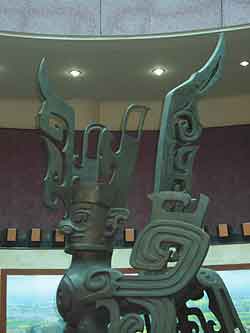 Fig. 3 Fanciful bronze statuary conveying "the Sanxingdui spirit" in foyer of Sanxingdui Museum, Guanghan City, Sichuan province [BGD] In 2003 the Sanxingdui Museum (Sanxingdui Bowuguan)(see Fig. 2) in Guanghan, Sichuan province, became the third tourism destination in China to be granted "Green Globe 21" certification by the Green Globe organisation based in Canberra, Australia. The grounds of the Sanxingdui Museum might well be green, but as a site museum Sanxingdui leaves much to be desired. More shrine than museum (see Fig. 3), the Sanxingdui Museum conveys no sense of the topography of the original archaeological site, although this may have change when construction of the entire park is complete. RUSSIAN FOLK MUSEUM OPENS IN HARBINIn June 2004 a Russian Folklore Museum (Eluosi Minsu Bowuguan) opened to the public in Harbin. Covering an area of 1,742 sq m, the museum features Russian-style architecture and has a collection of more than 5,200 articles of Russian folklorica. MUSEUM OF SHANNANThe first of its kind in Tibet, the new Shannan Prefecture History Museum (Shannan Zhou Lishi Bowuguan) showcases local Tibetan cultural treasures, highlighting the emergence and development of Tibetans in the Lhoka region in southern Tibet towards the Nepalese border. YAMEN MUSEUMThe yamen was the centre of administrative life in imperial Chinese cities. Its main hall presided over by the local or provincial magistrate was the equivalent of a chief magistrate's court, town hall, registry office and reception centre for visiting dignitaries. The residence of the local magistrate was adjacent, as was his garrison and prison, rendering the yamen a visible symbol of personal local power. Strangely there are few remaining examples of these architectural complexes, even though every Chinese urban centre once boasted its own yamen. In early 2004 China Daily reported that the best preserved and oldest example of a yamen is in Xinmi, a city in Henan province. Originally built in the Sui dynasty, the Xinmi yamen was destroyed in the Yuan and rebuilt in the Ming dynasty. Covering an area of 13,000 sq m, the museum, called in Chinese Xinmi Xianya Bowuguan, boasts a collection of more than 1,000 pieces. The newspaper reported that the complex had opened to the public as a museum, and the new museum contains displays of material documenting famous local people and magistrates, as well as ancient punishments and instruments of torture. Although China Daily claimed that the museum is "first of its kind in China", this is not correct. Baoding's yamen, once presided over by the redoubtable Zeng Guofan, a leading player in late Qing foreign relations, has served as a museum for nearly a decade and it too has displays of scenes from the official life of Zeng Guofan and exhibition halls filled with instruments of torture and punishment. GENGHIS KHAN MUSEUM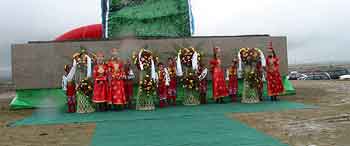 Fig. 4 Grouped "nationals" at the during the ground-breaking ceremony of the Inner Mongolia Mongol-Yuan Culture Museum, Xilingol, Inner Mongolia [BGD] Xilingol in western Inner Mongolia is attempting to transform itself into a cultural and tourist centre on the Mongolian steppes. One of the centrepieces of Xilingol's claim for the tourist dollar will be the Inner Mongolia Museum of Mongol-Yuan Culture (Neimeng Meng-Yuan Wenhua Bowuguan,)(see Fig. 4) an imaginative building that will surely take its place among the architectural follies of the 21st century as its design incorporates an Egyptian pyramid and sphinx, as well as tributes to Greco-Roman and Chinese architecture. The city government and the Mongol-Yuan Foundation invested heavily in a conference and exhibition at Peking University in late 2004, then bussed delegates to Xilingol for the museum's ground breaking ceremony. Participants also were provided with the opportunity to visit the nearby ruins of Xanadu (Shangdu)(see Fig. 5). 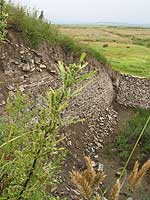 Fig. 5 Unearthed barbican gate at site of Mongol capital Shangdu (Xanadu), Zhenglanqi, Inner Mongolia [BGD] NEW MUSEUMS IN BEIJINGThere were a total of 121 museums registered in Beijing at the end of 2004, according to Beijing Administration of Cultural Heritage, and that figure is expected to top 130 by 2008, when Beijing will host the Olympic Games. In 1996 Beijing had only 96 museums. Among the most recently registered museums are the Imperial City Art Museum, located to the east of Tian'anmen Tower in Changpuhe Park, and the China Horse Culture Museum. The latter, called in Chinese Ma Wenhua Bowuguan, is located at the foot of the Badaling section of the Great Wall. There are also plans to include the collections of a number of princely mansions in a new Princely Mansions Museum (Wangfu Bowuguan) that will be housed in the grounds of Prince Gong's Mansion. In May 2005 Beijing News quoted Liu Chaoying of the Beijing Administration of Cultural Heritage as saying that Beijing will invest RMB 7 billion yuan (approx. USD 846 million) in the construction or reconstruction of six museums over the next five to 10 years. These include a museum dedicated to cinema, although no further details are forthcoming. According to the report, every Chinese medium-sized city will have a modern and functional museum by 2015. A number of major museums in the capital are being completely rebuilt. These include the China National Museum (Zhongguo Guojia Bowuguan, formerly known as Zhongguo Lishi Bowuguan), the China National Art Museum (Zhongguo Meishuguan), and the new Capital Museum (Shoudu Bowuguan), scheduled to open in late 2005. Backed by an investment of RMB1,200 million yuan (approx. USD144 million) by the municipal government, the new Capital Museum aims to become "China's best and most internationally advanced museum", thereby toppling the Shanghai Museum from its well-deserved position. The Capital Museum is moving from the Confucian Temple to a new home in the western section of Baiyun Road, along the extension line of western Chang'an Avenue. FIRST QIAOPI MUSEUM OPENS IN GUANGDONGIn April 2004 China's first museum dedicated to the Qiaopi - a kind of overseas remittance sent in a special envelope that Chinese who had emigrated to Southeast Asia in the early part of the last century used to send money back home - opened in Shantou, Guangdong province. Known in Chinese either as the Chaoshan Qiaopi Guan or the Qiaopi Wenwuguan, the museum has so far collected nearly 30,000 Qiaopi items, thousands of photos and records of Qiaopi, and old photographs of Qiaopi bureaux in Thailand. NATIONAL DIGITAL MUSEUMThe State Administration of Cultural Heritage is planning to launch an online digital museum, the China Digital Museum, described as a "virtual exhibition platform of all contents of Chinese cultural heritage". The museum is being developed with Beijing University of Aeronautics and Astronautics under the auspices of the Technological Information Section of the State Administration of Cultural Heritage. It has not yet been announced when the museum will go online. CHINA NATIONAL MUSEUM EXPANSION PROJECTIn 2005 the China National Museum (Zhongguo Guojia Bowuguan) on the eastern side of Tian'anmen Square in Beijing will undertake the major part of its restructuring and expansion project that has been underway for the past two years. The central government is investing RMB 1.8 billion yuan (USD217.65 million) in the project, expected to be completed in 2007. A German design company, GMP, is undertaking the key work in the project. It is anticipated that in 2007 the museum will cover a total floor space of 150,000 square metres, compared with the present 85,000 square metres. Exhibition halls will occupy 35,700 square metres, including 15 theme exhibition halls, four non-regular exhibition halls, five halls for international exchange and four halls for donated articles. Other facilities will include a digital cinema, ceremony hall, data centre, parking lot, bookstore, and shops. The China National Museum was established with the merger of the Chinese National History Museum and the Chinese Revolutionary History Museum in February 2003. JEWISH MUSEUM IN SHANGHAIShanghai's flourishing Jewish community on the eve of World War II is documented in two small exhibition rooms on the second floor of what was once the Ohel Moishe Synagogue, located in Changyang Road. The Ohel Moishe Synagogue founded in 1907 is one of the only two surviving synagogues in Shanghai. It is estimated that more than 30,000 Jews made their home in Shanghai in the 1930s and 1940s as they fled persecution in Europe. CHINA'S BIGGEST BAMBOO AND WOODEN STRIPS MUSEUMChina's largest museum exhibiting ancient bamboo and wooden strips opened in October 2004, after three years' construction. Located in Changsha, Hunan province, the museum was co-funded by the State Administration of Cultural Heritage and the municipal government. The three-storey museum, designed in a pseudo-Han dynasty architectural style, covers more than 12,000 sq m. The museum is designed to house several valuable collections of slips, including 140,000 inscribed bamboo and wooden strips of the Three Kingdoms period (220 to 280 CE) unearthed at Zoumalou in Changsha in 1996 and another 10,000 from the Han dynasty discovered in 2003. CONSTRUCTION OF THE NATIONAL MUSEUM OF THE HISTORY OF THE OVERSEAS CHINESEOn 31 March 2004 China Daily reported from Bo'ao, Hainan province, that a spokesman of the All-China Federation of Returned Overseas Chinese had announced that construction of the National Museum of the History of the Overseas Chinese would begin in Beijing at the end of 2004. The museum will cover 10,000 sq m and display more than 200,000 exhibits, including illustrations and artefacts. MUSEUM CELEBRATES 600TH ANNIVERSARYIn December 2004, the new Tianjin Museum, which covers an area of 50,000 sq m and houses 200,000 objects, opened to the public with an exhibition celebrating the 600-year history of this port city. The new museum integrates the collections of the Tianjin Art Museum and the Tianjin Historical Museum. NEW MUSEUM IN SHANGHAIIn October 2004 the new Qingpu Museum opened in Shanghai. Construction of this butterfly-shaped building began in 2002. The museum has a collection of more than 2,000 "cultural relics", including neolithic material from the Majiang and Songze cultures. Tang dynasty artefacts reveal that Qingpu was a flourishing town as early as the Tang dynasty. FOLK COSTUME MUSEUM FOR SHANGHAIA museum dedicated to the professional study of Chinese costume history will open to the public in Shanghai in November 2005. Preparations for the opening of the Chinese Attire and Costume Museum involve professors and students of Shanghai's Donghua University, which specializes in textile and costume studies and was known as China Textile University prior to 2002. Bao Mingxin, a specialist in Chinese costume history at the university, heads the preparatory team. The museum has collected more than 600 exhibits from three sources: 400 from the university's collections, 100 costumes donated by enthusiastic citizens, and 100 costumes donated by the Ningbo-based, garment-making group Youngor. The collection includes a kesi silk dragon robe made during the reign of the Guangxu Emperor (1871-1908). DIGITAL DUNHUANGDigital technology has a major role to play in cultural relics protection. Digital Dunhuang, a project of the Dunhuang Institute funded in part by the Mellon Foundation, was initiated in 1998 with support from the Mellon Foundation, and in mid 2004 Li Zuixiong, vice-president of the academy, announced that the measurement, shooting and compilation of 22 caves had been completed and the cyber viewing schemes have been developed for another 42 caves. Another project, the "Digital Dunhuang Library Cave", is also well underway. Digital versions of manuscripts and painting scrolls from the library cave now have almost every detail of the documents, which were difficult to view under magnifiers. In mid-May 2004, a digital Dunhuang website went into operation in the Chinese language, which allows viewers to scan nearly 10,000 titles of digitized Dunhuang records and 300 images of mural paintings and sculptures. To view the contents of the Mellon International Dunhuang Archive, as the project is formally titled, go to: www.artstor.org/info/collections/mida.jsp. CHINA'S FIRST DRAMA MUSEUM TO BE LAUNCHEDTowards the end of 2004, the Drama Museum of the Beijing People's Art Theatre opened to the public. The museum has a collection of more than 150,000 items, including manuscripts by the 20th century playwrights Guo Moruo, Lao She, Cao Yu and Shen Congwen. CHINA GEOLOGICAL MUSEUM RE-OPENSChina Geological Museum, the largest museum of its kind in Asia, re-opened in Beijing in July 2004 after undergoing more than three years' renovation. The museum, located in the downtown area, has an exhibition space of 4,500 square meters, and includes a hall with early human fossils, including the first copy of the Peking Man skull and teeth of the 1.7 million year-old Yuanmou hominid found in south-western China. AGRICULTURAL HISTORY MUSEUM TO BE BUILT IN XI'ANIn September 2004 construction of the China Agricultural History Museum (Zhongguo Nongye Lishi Bowuguan) began in Xi'an. The museum will cover 5,000 sq m, and will focus on the agricultural history of western China. As well as housing ancient documents and artefacts related to agriculture, the museum is intended to serve as a research centre.[BGD] |